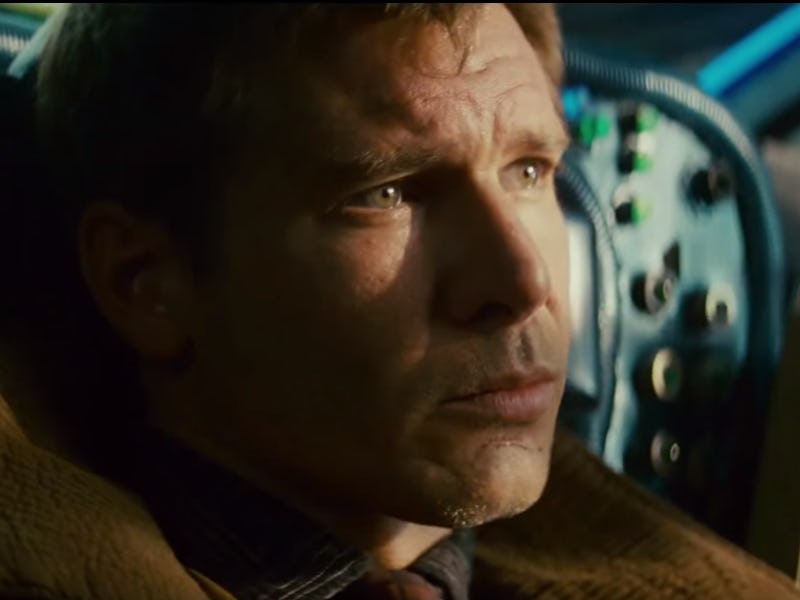Remembering 'Blade Runner 2,' the Novelized Sequel to the Movie
A book sequel was published in 1995. Why haven't we heard anything about it now that the movie is getting a sequel?

Damn, remakes and reboots, you had enough yet? How far back in time do you have to reach? At this point, Hollywood is dredging up its oldest properties, at the very back of the drawer, to play on our nostalgia. Thing about that strategy, though, is it works — just look at Indiana Jones and the Kingdom of the Crystal Skull becoming a massive hit, or Bruce Willis churning out more Die Hard movies, or The Force Awakens. Now comes the impending sequel to Ridley Scott’s groundbreaking 1982 film Blade Runner. Except — wait, there already was a Blade Runner 2.
Director Denis Villeneuve’s upcoming cinematic continuation of the exploits of maybe-human-maybe-replicant Rick Deckard has again recruited Harrison Ford to reprise his role. It’s probably Ford’s third-most iconic onscreen turn, and fittingly it’s the third time he’s revisited an old character like Han Solo or Indiana Jones decades after the previous installment. Ford apparently loves the screenplay to the sequel, which is written by original scribe Hampton Fancher with the help of writer Michael Green. The star went so far as to tell original director Ridley Scott, “This is the best script I’ve ever had.”
With nothing known about the sequel other than that it will take place nearly 30 years after the original, and that Villeneuve says he will “take care of [the] mystery” that has kept fans guessing ever since the movie defined 1980s sci-fi. Plot details are vague. But when they pick up production on the new movie in the summer of 2016 maybe they’ll take some cues from Blade Runner 2: The Edge of Human.
Blade Runner 2: The Edge of Human was a 1995 novel written by prolific, but relatively unknown sci-fi writer K.W. Jeter. He seems to be one of those tried-and-true sci-fi wordsmiths who prefers quantity over quality with nothing ever being qualified as a rousing success, though he may be remembered as the guy who coined the term “steampunk.” After starting out writing sci-fi novels of his own in the mid-’70s, and continuing on with short fiction and essays, the writer was eventually tapped to write a sequel to the movie Blade Runner. Critics of Blade Runner 2: The Edge of Human ripped its decision to ignore revered sci-fi writer Philip K. Dick’s original Do Androids Dream of Electric Sleep novel altogether. Instead, Jeter wrote his own incongruities into the story based off of the plot holes from the movie.
In his review of the book, Entertainment Weekly writer Michael Giltz called it “literary necrophilia,” explaining that “only hardcore fans will be satisfied by this tale of Deckard, the cynical ex-LAPD blade runner, here forced to hunt down yet another runaway replicant.” He ultimately concluded that Jeter’s “habit of echoing dialogue and scenes from the film is annoying and begs comparisons he would do well to avoid” before branding it with a “C-” rating. Why the harsh words?
The story of The Edge of Human begins months after Deckard escapes with Rachael the replicant at the end of the movie, picking up in a shack outside of Los Angeles. There he is contacted by Sarah Tyrell, the niece of the robotic mastermind from the movie and tasked with tracking down an unmentioned sixth replicant, basically making it a lazy retread of the movie. Though in a surprising twist, the human basis for the movie’s Roy Batty replicant tries tracking down Deckhard, whom he thinks is the sixth replicant.
The plot chugs along from there, randomly resurrects dead characters from the movie (hiya, J.F. Sebastian) and the evil replicant Pris before concluding in a twist ending involving Deckhard again escaping with Rachael who ends up actually being the very human Sarah.
The book itself isn’t difficult to track down. New paperback copies can be found on Amazon for $17, while used ones go for the low, low price of a penny. If you’re still on the fence about the relative quality of the book, the Amazon reviews are particularly entertaining and enlightening. One user, named “A Customer,” says “There are some nice ideas at work here but overall it just seems like a tired excuse for cashing in on the Blade Runner phenomenon.” And cash in Jeter did.
He also wrote two further authorized sequels in 1996 and 2000. Blade Runner 3: Replicant Night and Blade Runner 4: Eye and Talon continued Deckhard’s futuristic storyline on Mars and introduced a completely new female blade runner-centric plot, respectively. But with the new official movie sequel in the works, chances are Jeter’s storylines disappear into the ether of a new throwaway expanded universe. As Star Wars has done away with extraneous plots and characters introduced in the hundreds of its own off-cute book titles (some of which were also written by Jeter), so will these. Maybe it’s better off that way.